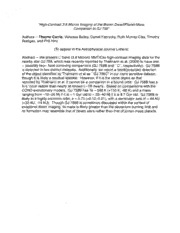
NASA Technical Reports Server (NTRS) 20110020762: High-Contrast 3.8 Micron Imaging of the Brown Dwarf/Planet-Mass Companion to GJ 758 PDF
Preview NASA Technical Reports Server (NTRS) 20110020762: High-Contrast 3.8 Micron Imaging of the Brown Dwarf/Planet-Mass Companion to GJ 758
"High-Contrast 3.8 Micron Imaging of the Brown Dwarf/Planet-Mass Companion to GJ 758" Authors -- Thayne Currie, Vanessa 8ailey, Daniel Fabrycky, Ruth Murray-Clay, Timothy Rodigas, and Phil Hinz (To appear in the Astrophysical Journal Letters) Abstract -- We present L' band (3.8 Micron) MMT/Clio high-contrast imaging data for the nearby star GJ 758, which was recently reported by Thalmann et al. (2009) to have one -- possibly two-- faint comoving companions (GJ 7588 and "C", respectively). GJ 7588 is detected in two distinct datasets. Additionally, we report a \textit{possible} detection of the object identified by Thalmann et al as "GJ 758C" in our more sensitive dataset, though it is likely a residual speckle. However, if it is the same object as that reported by Thalmann et al. it cannot be a companion in a bound orbit. GJ 7588 has a H-L' color redder than nearly all known L--T8 dwarfs. 8ased on comparisons with the COND evolutionary models, GJ 7588 has Te - 560 K (+150 K, -90 K) and a mass ranging from -10--20 Mj if it is -1 Gyr old to - 25--40 Mj if it is 8.7 Gyr old. GJ 7588 is likely in a highly eccentric orbit, e - 0.73 (+0.12,-0.21), with a semimajor axis of - 44 AU (+32 AU, -14 AU). Though GJ 7588 is sometimes discussed within the context of exoplanet direct imaging, its mass is likely greater than the deuterium-burning limit and its formation may resemble that of binary stars rather than that of jovian-mass planets.
